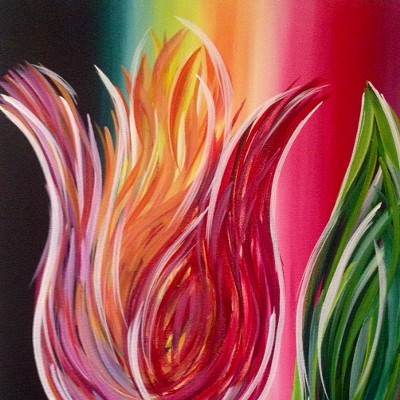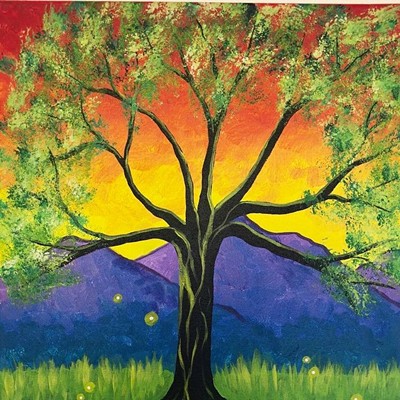Herself a well-known painter, poet and feminist, Stevens is fit at 76, and her black pants and jacket tend more toward artist's cool than widow's weeds. She's nevertheless at the museum for the opening of a Baranik retrospective to promote the work of her husband, an acclaimed painter and political activist who died in 1998. She's got plenty of her own paintings still to paint and poems to write, but "I feel a responsibility," she explains. "His after-life depends on me. He would have done it for me."
Opposite her perch on the bench is "Dimmed Light," a 1961 oil on canvas that's classic Baranik, an elegant abstracted composition in blacks, whites and grays.
"He was a good colorist," Stevens maintains. "He knew about warm-cool painting--the grays work like color."
She's right. The vertical painting is a splendid if subtle celebration of grays, from pink-gray to blue-gray to pearl to charcoal to white. As Stevens notes, Baranik reveled in the paint's texture, lavishing it by turns thickly and thinly, carving it up, scraping it off. And like all of his paintings, "Dimmed Light" hints at something beyond its beautiful forms and pigments. A vaguely defined light bulb is slowly dimming, and the shapes that are losing its light suggest a troubling reality beyond abstraction. Their curving shapes could be land masses. Or piled-up dead bodies.
Baranik's paintings are full of elegies for the dead as well as longing for a lost land. He was that rare creature, a political abstractionist, or as he liked to call himself, a practitioner of "socialist formalism." His searing Napalm Elegy series, painted during the war in Vietnam, are explicit critiques of that war's human fallout. In "Napalm Elegy I," 1974, a large white human head, made of cracked pieces of canvas glued and scarred by shadows, floats above a horizon line. In "Napalm Elegy ES," 1973, a similar cracked head is buried in an earth composed of collaged newsprint.
Art historians link Baranik's political commitments and subdued palettes to Picasso's pivotal painting "Guernica," but some of the paintings in this show have the sinewy savagery of a Francis Bacon. "Sleep Well," 1986, a monumental two-canvas work, has a horizontal pile-up of horrifying forms, in reds and whites and charcoal, against a strip of deep gray sky. It suggests butchery, and a mass grave.
"The Evening After," from 1997, the last work Baranik ever painted, is a mournful landscape in which dozens of eyeglasses are buried beneath a turbulent sky. Stevens says it was painted after Baranik's final visit to his home village in Lithuania, where he was born in 1920. It commemorates the 1940 massacre of the town's 2,000 Jews, among them Baranik's mother, father and 10-year-old sister. The eyeglasses memorialize his family. "My people were readers," Baranik used to say.
"It was a savage thing that happened to him," Stevens says.
If this early holocaust shaped his art and his politics, Lithuania's flat northern landscape, with its dark colors and monochromatic winters, found its way into his palette. (In an essay written for the exhibition, critic Lucy Lippard notes that Baranik loved New Mexico, where he and his wife moved the year before he died, "because the cold starry skies reminded him of his childhood.") The horizon line in nearly all his abstractions mimics the lost land of his childhood.
"There was an unbridgeable gap between the first 18 years of his life and the rest of his life," Stevens says. His family had sent him off to an uncle in Chicago in 1938, ostensibly so he could get an education, but more likely to save his life. He served in the U.S. Army in World War II, and in 1948 at 28 met the 24-year-old Stevens in a painting studio at the Art Students League in New York.
"I recognized him in my mind as the person I wanted," his wife says with a smile. They married within months and went off to Paris, where Baranik studied with Fernand Léger, and delved into work that attacked racism and war.
When they came home to New York in 1951, Stevens says, they encountered the work of the Abstract Expressionists. Both painters were interested in the new painting, but Stevens continued with large-scale figurative work, and Baranik forged ahead with his socialist formalism. Through all his years of committed political activism, performing in guerrilla street theater or lugging body bags through Central Park as a member of Angry Arts, Baranik the painter expressed his politics in the language of near-abstraction. Baranik saw no contradiction between the dictates of formalism and his own opposition to the Vietnam War, to a racist prison system or to the death penalty.
"For some, the formal language of abstract expressionism is it," Stevens says. "But for him, the techniques were interesting but they were not the subject ...
"He worked politically because it was important to him. He was not naïve. He knew abstract art spoke to few people. In his paintings, he couldn't separate the two. He was deeply political. He was giving people hope, or maintaining his own hope."
An exhibition of Rudolf Baranik's paintings continues through Sunday, January 14, at the University of Arizona Museum of Art. Museum hours are 9 a.m. to 5 p.m. Monday through Friday, noon to 4 p.m. Sundays. The museum will be closed this week on Thursday and Friday for Thanksgiving, and will close again on December 24, 25 and 31, and January 1. All other hours remain the same during the holiday period.
A series of free talks related to the exhibition will be held at the museum. New York art critic Donald Kuspit lectures at 7:30 p.m. Thursday, November 30. Ellen McMahon, a UA professor of visual communications, speaks about text, image and activism at 2 p.m. Sunday, December 3. Mark Luprecht, a UA humanities professor, gives a talk on art and existentialism at 2 p.m. Sunday, December 10. For more information call 621-7567.














